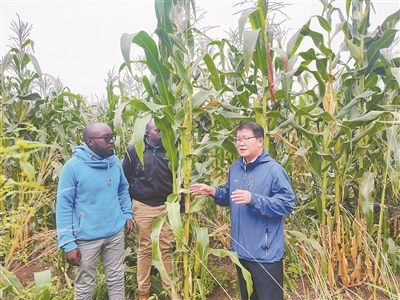
By?WANG Yingxia, JIE Manbin, LI Yuhan, ZHAO Yingshu, LIN Lijun, TENG Jipu & LIANG Yilian
At the Katumani Experimental Station in Kenya, each corn plant stands over two?meters tall, and the corn cobs?are large with a big yield. Meanwhile, corn growing in nearby fields?struggle to grow to about one meter in height.
The corn in the experimental station has undergone mulching treatment by a Chinese agricultural team?which hails from?Lanzhou, Gansu Province in Northwest China. After nearly 30 trips to Kenya, team leader Xiong Youcai?recently brought China's ridge-furrow plastic film mulching technology to Kenya.
This year marks the 12th anniversary of the establishment of the cooperative relationship between the two sides. Apart from increasing the corn plants height, the leaf area has also significantly increased, resulting in a yield increase of 99?percent?to 240?percent. Additionally, water use efficiency has improved by 127?percent to 247?percent.
Kiprotich Wesly Cheruiyot, a Kenyan doctoral student at the College of Ecology, Lanzhou University, went to China six years ago and traveled to most villages in Gansu Province to do research with Professor Xiong’s team from the same college.
"After graduation, I will definitely return to my Kenya and promote China's mulching technology throughout the country," said Cheruiyot.
Kenya embraces new tech
Kenya is located in East Africa, with the equator crossing through its central region. Over 80?percent?of the country's land area is in arid or semi-arid regions.
In August 2011, the Ministry of Science and Technology of China, in collaboration with the United Nations Environment Programme, officially launched a water resource?technology cooperation project in Africa. Due to his technical expertise and rich experience, Xiong Youcai led a research team to conduct investigations in the local area.
At that time, Kenya had just experienced a three-year-long drought, causing almost complete crop failure for farmers.
The challenges faced by agricultural development in Kenya have also plagued the people of China's northwest arid and semi-arid regions for a long time. It wasn't until the 1980s that the ridge-furrow plastic film mulching technology was widely promoted on the Loess Plateau, greatly improving water efficiency. It also has the advantages of low cost, high income, easy operation and labor saving.
In simple terms, this technology involves creating ridges in the field, covering them entirely with plastic film, and sowing crops in the furrows.
"You see, the alternating ridges and furrows in the field have become a gathering place for rainwater, haven't they? The different-sized ridges can channel and seep the tiny rainfall to the roots of the crops," said Xiong.
Given the complexity of both natural and social conditions, drip irrigation technology from developed countries like Japan and Germany was also experimented with in Kenya. However, due to various reasons, including cost, it was not used?by the country’s poor.
"The initial investment is too high, and farmers will definitely not accept it. That's a given," said Cheruiyot. "Only when the cost comes down and the technology is not too complex, will there be a possibility for widespread adoption."
New environment brings new challenges
While the ultraviolet radiation in Northwest China is already intense, in equatorial Kenya?it is even more so. Under this dual onslaught of ultraviolet rays and ground temperatures, the plastic film showed signs of dissolution and damage in less than three days.
"People need time to adapt to a new environment, let alone a small piece of plastic film," said Mei Fujian, a team member and a doctoral student at the College of Ecology at Lanzhou University, "Just like people, plastic film needs to adapt to the local conditions,” she said.
The team quickly came up with a solution through brainstorming, deciding to improve the material of the plastic film, including measures like adding carbon powder to enhance its resistance to ultraviolet radiation.
Due to its strong light-blocking properties, the improved black plastic film not only effectively suppressed weed growth but also lowered the field temperature. This meant that the "greenhouse" environment where pests and diseases thrived was eliminated, and the farmland, which had long been plagued by pest infestations, was rejuvenated.
A green test field on the East African plateau
Currently, Professor Xiong’s?team has established eight technical demonstration sites across Kenya, covering an area of 3,000 acres.
"This is a very good opportunity for agricultural development in the arid and semi-arid regions of Kenya. I believe we can seize this opportunity and retain?the practical dryland agricultural technology," said Dr. Patrick Gicheru, Director of the Kenya Agricultural Research Institute, regarding the ridge-furrow plastic film mulching technology.
In Professor Xiong’s?view, this signifies a phased success in the promotion of this technology. What makes him even happier is that countries like Ethiopia and Pakistan have also adopted the ridge-furrow plastic film mulching technology.
"When I see the lush and thriving experimental fields on the East African plateau, I feel that all the hardships I've experienced were worth it," said Professor Xiong Youcai.
The trio will conduct a series of experiments in fields such as life science, fluid physics, combustion science and materials science. Notably, this is the first time that fruit flies have been taken on a Chinese space mission as experimental subjects. What made scientists choose fruit flies? What experiment will they undergo?
